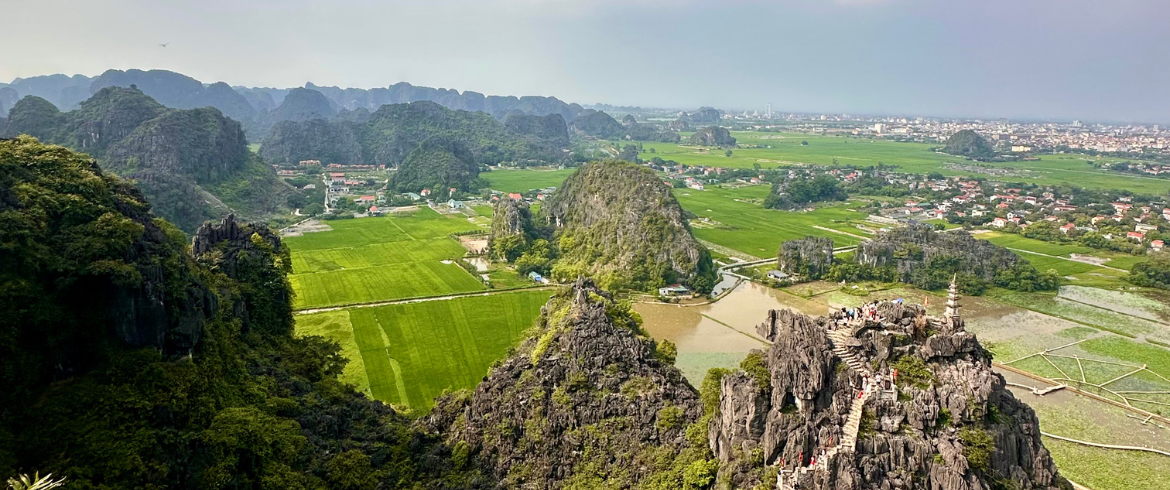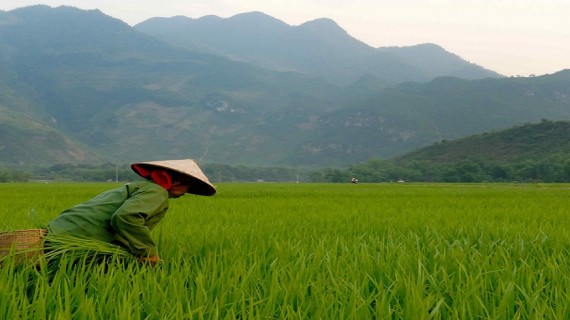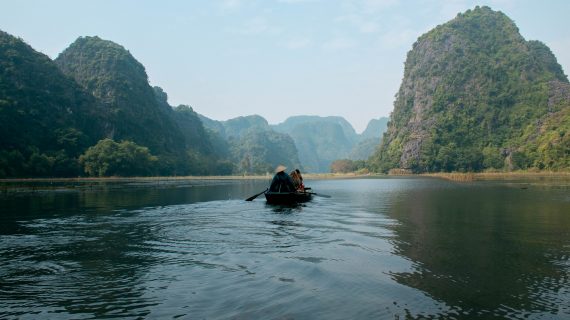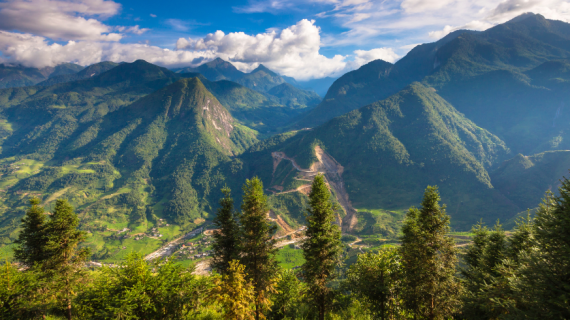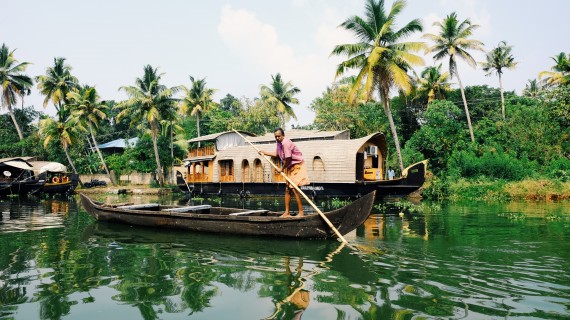Located in northern Vietnam, Ninh Binh is a true paradise for nature and culture lovers. Recognized as a UNESCO World Heritage Site for its exceptional landscapes and historical significance, the region is where breathtaking scenery meets centuries-old heritage. It’s a living example of how ecotourism can work, with conservation and local communities thriving together.
There, travelers can hike through limestone valleys, walk among golden rice fields, cycle along peaceful village roads, or go down emerald rivers in traditional rowboats guided by locals (no engines, no emissions, just the soft rhythm of paddles on water). Ancient pagodas and temples rise from the mist, adding a sense of serenity to this timeless landscape.
This place gave me the certainty that sustainable travel is really tangible. For travelers looking for conscious, slow, low-impact experiences, Ninh Binh offers real proof that ecotourism can be done right, where natural beauty, community well-being, and responsible travel truly come together.
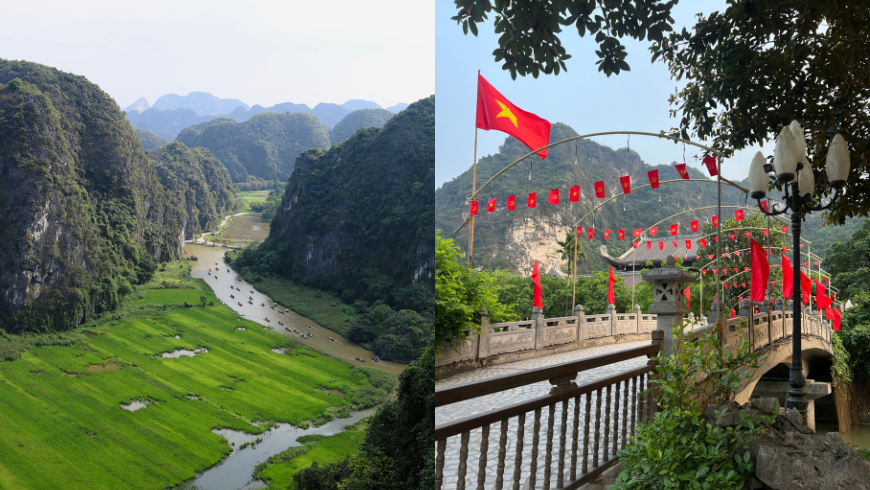
Why Ninh Binh is a Model for Ecotourism and Sustainable Travel
Ninh Binh is not only a beautiful scenery, but it’s a working example of how ecotourism can work out when people, nature, and culture are treated as one connected system. It’s a living classroom about sustainability. The region shows how tourism can protect the environment, empower local people, and keep traditions alive when managed with care.
UNESCO Heritage & Responsible Management
The Trang An Landscape Complex was inscribed as a mixed natural and cultural UNESCO World Heritage Site in 2014. Its recognition comes from its dramatic limestone formations, river valleys, caves, temples, and archaeological remains.
To preserve this fragile ecosystem, authorities have restricted motorized boats, organized tours along fixed routes, and created buffer zones. Environmental and heritage impact assessments are mandatory, ensuring that conservation always comes before mass tourism.
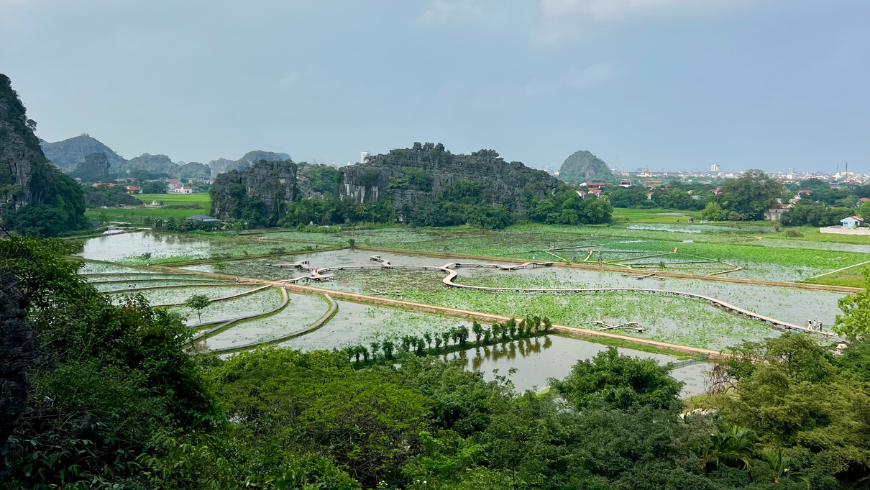
Local Community Involvement & Shared Benefits
Many of the boat rowers in Trang An or Tam Coc are local villagers who once depended solely on farming. Tourism now provides them with fair, stable incomes — without leaving their homes or traditions behind. Each boat ride directly supports a local family, keeping profits within the community instead of large corporations.
In Cuc Phuong National Park, Muong families open their stilt houses to visitors, offering meals, music, and authentic hospitality. These community-based stays let travelers experience rural life while contributing to forest protection and cultural preservation.
That’s what makes ecotourism in Ninh Binh such a success story.
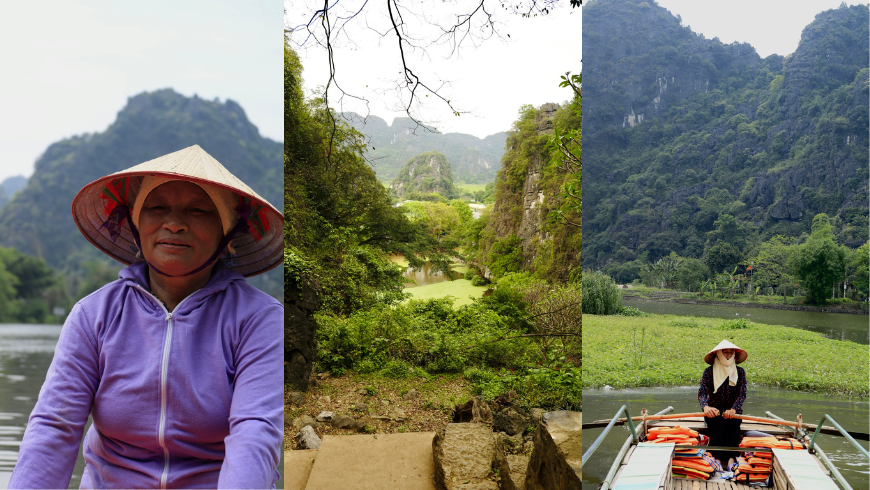
Conservation & Education
Sustainability in Ninh Binh goes far beyond green marketing. The region is home to ongoing conservation work — from primate and turtle rescue centers to forest restoration and biodiversity research.
At Cuc Phuong, guided walks, night safaris, and educational tours teach visitors about native species and the importance of protecting them. It’s travel that raises awareness, inspiring respect, not just admiration.
Monitoring & Responsible Development
Authorities have learned from both success and past mistakes. Development projects are now carefully reviewed for their environmental impact, and strict rules prevent over-tourism. Visitor routes are designed to distribute traffic evenly, easing pressure on sensitive ecosystems.
The result is a destination that remains accessible, authentic, and peaceful — a model for sustainable tourism in Southeast Asia.
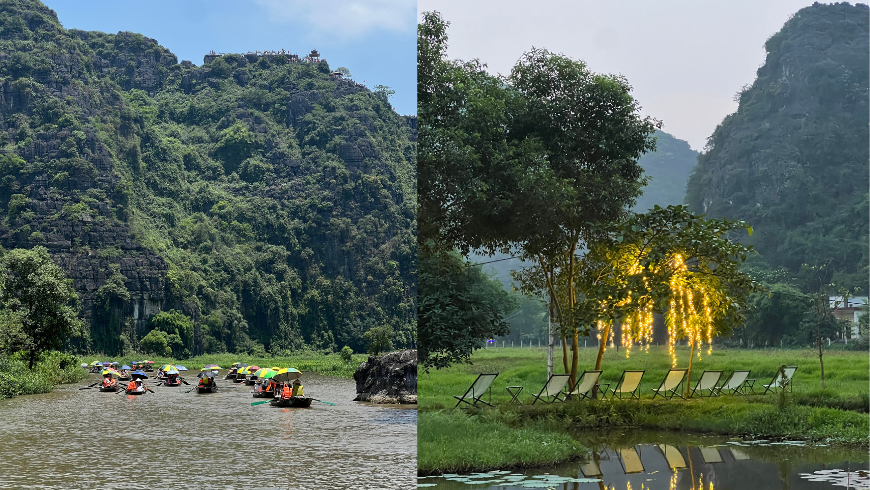
Planning Your Trip – Tips for Sustainable Travel in Ninh Binh
Best Time to Visit
The most pleasant months are November to April, when the air is clear and dry. The rice paddies shift from emerald to gold depending on the season, and river trips feel calm and unhurried.
Getting There
From Hanoi, Ninh Binh is about a 2.5-hour drive south. The easiest and most comfortable option is a shared limousine van, which most hotels in Hanoi can arrange. You’ll be picked up at your door and dropped off right at your homestay or hotel. Other options include the train (about 2 hours), private taxi, or an organized day tour, but if you have time, staying a night or two is far better than rushing it.
How Long to Stay
While many people come just for a day, 2–3 days, but I really recommend staying around 4–5days if you are a lover of slow travel and likes to get to know the place deeper. You will have plenty of time to see all the landscapes at sunrise and sunset, when the light is magical and crowds are thin. It also gives you time to slow down: cycle through villages, enjoy local meals, or simply listen to the quiet.
Getting Around
Cycling is one of the best ways to explore. Many stays in Tam Coc or Trang An provide free bikes, and most roads are flat and scenic. You can also use Grab (Vietnam’s version of Uber) or rent a electric or motor bike for a bit more freedom.
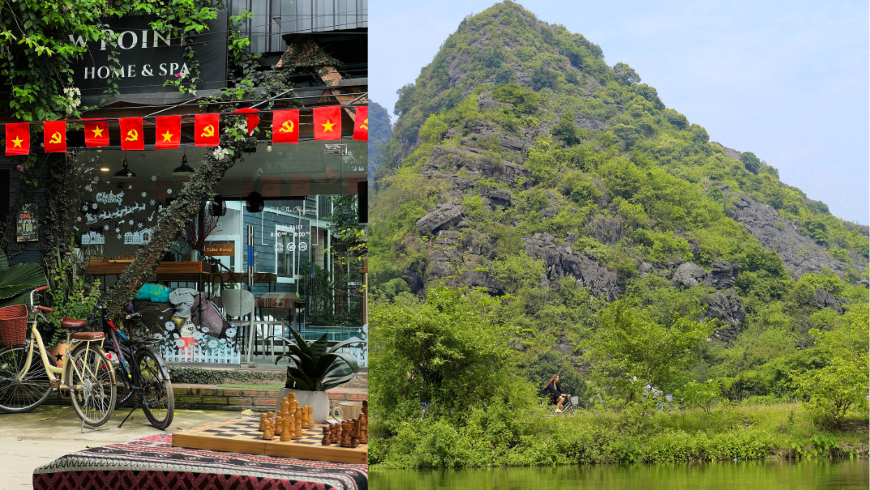
Where to Stay
Choose something close to Tam Coc or Trang An — both are surrounded by karst cliffs and easy to navigate.
Activities Worth Experiencing
That are so many amazing things to do in Ninh Binh! You can explore nature, do hikes, enjoy the landscape, but you can also explore its culture that it is extremelly rich, layered, and deeply integrated with daily life. To travel sustainably here also means to immerse respectfully in local traditions and spiritual heritage.
Mua Cave Viewpoint
Climb the 500 stone steps to the top for one of the most breathtaking views in Vietnam. The dragon statue and limestone peaks look especially beautiful at sunset, when the valley glows. The path is steep but short, and the reward is unforgettable.
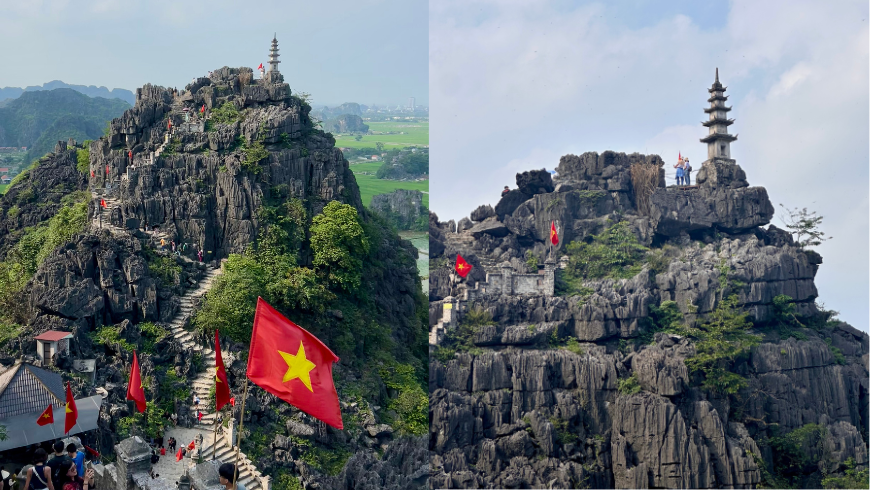
Boat Trip through Trang An or Tam Coc
This is the soul of Ninh Binh: traveling along emerald rivers between towering cliffs, through caves, and past hidden temples.
The best part? The locals row the boats using their feet, a skill passed down through generations — completely human-powered, silent, and beautifully sustainable.
- Trang An is more extensive and serene, with multiple routes and temples to explore.
- Tam Coc is closer to town and passes through lotus ponds and rice fields.
Either way, local women row the boats (often with their feet) and it’s worth tipping them at the end for their incredible work.
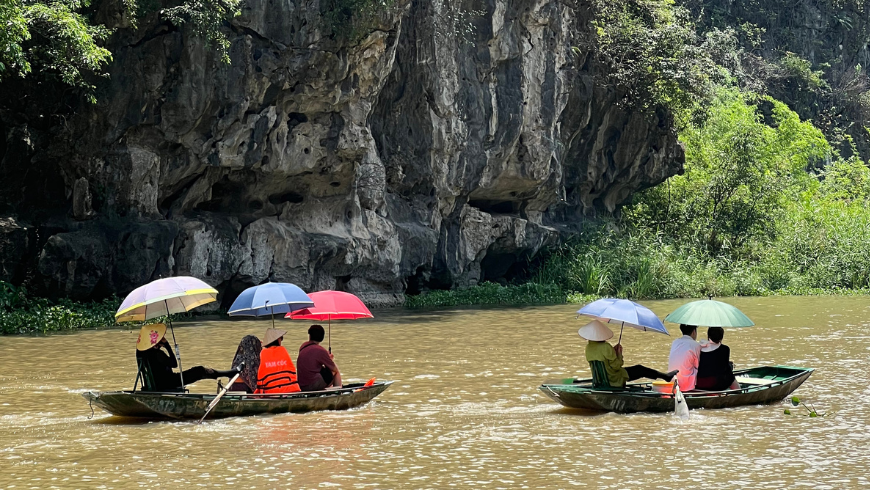
Bich Dong Pagoda
Known as the “Green Pearl Cave,” this 15th-century pagoda is tucked into a limestone hill. Climb through the three levels of temples, light an incense stick, and look out over the rice fields below. Early morning is peaceful and photogenic.
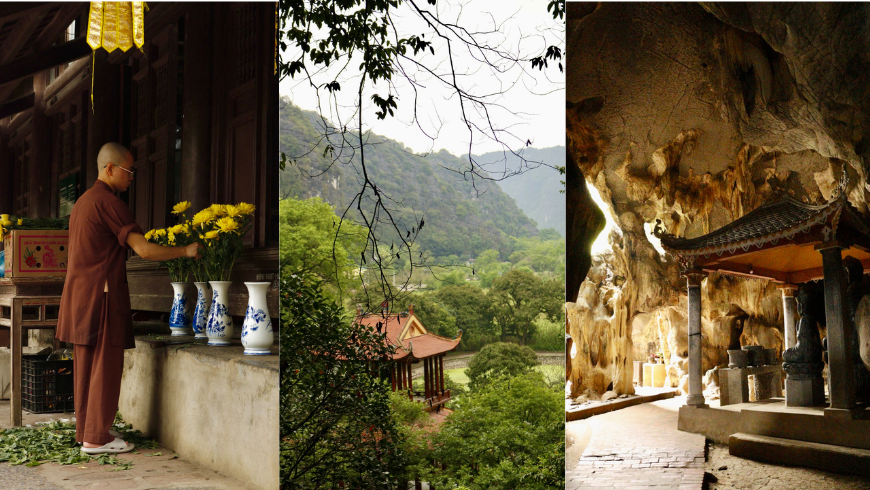
Bai Dinh Pagoda Complex
The Bai Dinh Pagoda is one of the largest spiritual complexes in Southeast Asia! Its an extraordinary place where grand architecture meets deep calm. Its scale is almost hard to believe: countless Buddha statues, towering temples, long corridors lined with carvings, and sweeping roofs glowing in gold tones as the light changes through the day.
The best way to experience it is to arrive early and stay until sunset. The atmosphere completely transforms as the evening lights turn on and the sound of bells echoes across the hills. The complex is huge, so electric carts take visitors around — a practical and eco-friendly way to explore without rushing.
Bai Dinh isn’t just impressive; it’s alive with spiritual energy. Whether you come to admire the views, learn about Buddhism, or simply find a quiet moment among the courtyards, this place leaves a deep impression.
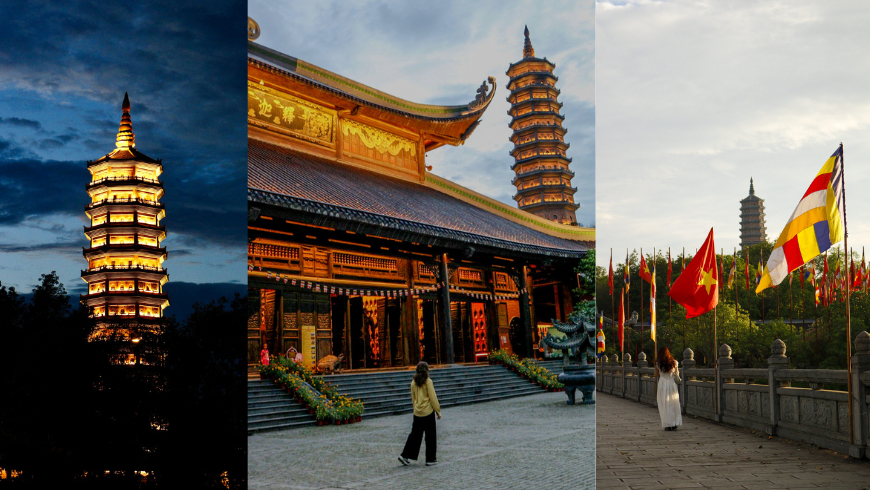
Hoa Lu Ancient Town at Night
When the sun sets, Ninh Binh reveals a softer side. Around the lake at Hoa Lu Ancient Town, temples glow in warm light, their reflections shimmering on the water while lanterns float gently by.
That are so many resaurants that visitors can enjoying traditional dishes under strings of flags and soft music. Although newly built, the area celebrates Vietnam’s timeless architecture and spiritual calm. Walking there feels like stepping into a living painting (peaceful, cultural, and filled with life) a beautiful way to end a day exploring Ninh Binh’s natural wonders.
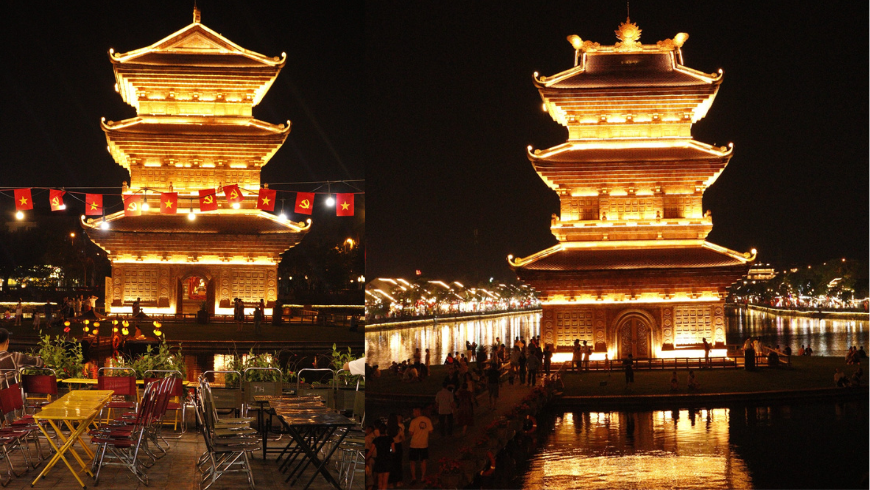
Final Thoughts
For travelers interested in sustainable travel in Ninh Binh, the experience goes beyond sightseeing.
Ninh Binh is one of those rare places that truly stay with you. It shows how nature, culture, and community can exist in harmony – not just as an idea, but as a way of life. Traveling here reminds you that sustainability isn’t about doing less, it’s about doing better – with respect, curiosity, and connection.
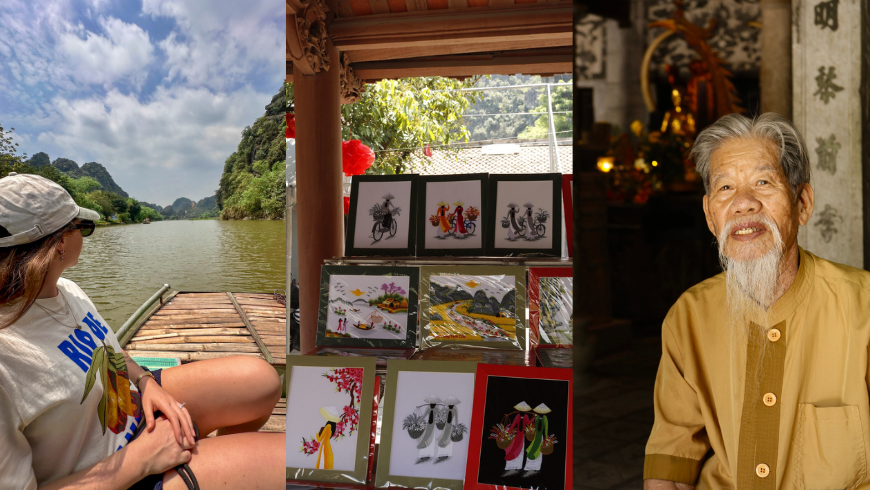
Whether you’re gliding along quiet rivers, walking through rice fields, or sharing a meal in a local home, every moment in Ninh Binh feels authentic. It’s a destination that doesn’t just inspire you to explore, but to care, for the land, the people, and the stories that make it so special.
